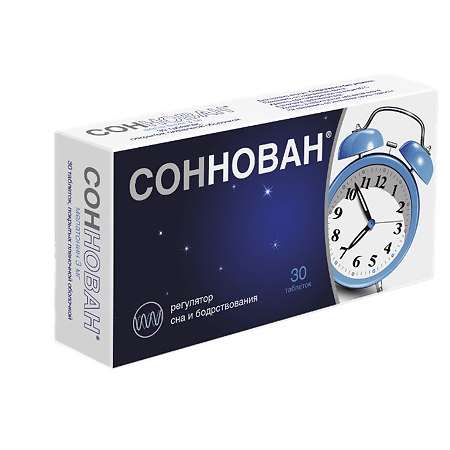No products in the cart.
Sonnovan, 3 mg 30 pcs
€13.06 €11.43
EAN: 4630030920304
SKU: 259280
Categories: Medicine, Neurology and Psychiatry, Sedatives and hypnotics
Description
In disorders of sleep, including those caused by a violation of the rhythm of “sleep-wake”, such as desynchronosis (sudden change of time zones).
Active ingredient
Active ingredient
Composition
Composition
film-coated tablets
1 film-coated tablet contains:
active ingredient:
Melatonin 3 mg;
auxiliary substances:
calcium hydrophosphate 112 mg,
corn starch pregelatinized 3.5 mg,
magnesium stearate 1.5 mg,
microcrystalline cellulose 40 mg;
coating composition:
opadray 85F48105 II white 5 mg, including:
polyvinyl alcohol 2.345 mg,
macrogol (polyethylene glycol 4000) 1.18 mg,
talc 0.87 mg,
titanium dioxide 0.605 mg.
How to take, the dosage
How to take, the dosage
Ingestion. In sleep disorders, desynchronosis – 1 tablet once a day 30-40 minutes before sleep.
If it is used as an adaptogen when changing the time zones, 1 day before the flight and during the next 2-5 days 1 tablet 30-40 minutes before sleep.
The maximum daily dose is 6 mg.
Elderly patients
Melatonin metabolism decreases with age, which must be considered when choosing a dosing regimen for elderly patients. Because of this, in elderly patients, it is possible to take the drug 60-90 minutes before sleep.
Renal failure
The effect of varying degrees of renal failure on the pharmacokinetics of melatonin has not been studied, so melatonin should be used with caution in these patients. In patients with severe renal impairment, use of the drug is not recommended.
Interaction
Interaction
Pharmacokinetic interaction
Pharmacodynamic interaction
Special Instructions
Special Instructions
During the use of Sonnovan® , it is recommended to avoid exposure to bright light.
Women who want to get pregnant should be informed about the weak contraceptive effect of the drug.
There is no clinical data available on the use of melatonin in patients with autoimmune diseases; therefore, it is not recommended for this patient population.
Influence on driving and operating ability
The drug Sonnovan® causes somnolence and therefore the patient should refrain from driving and engaging in potentially dangerous activities requiring increased concentration and quick psychomotor reaction.
Contraindications
Contraindications
Hypersensitivity to the components of the drug, autoimmune diseases, liver failure, severe renal failure, children under 18 years of age.
Side effects
Side effects
Classification of the frequency of side effects according to the recommendations of the World Health Organization:
Very common (≥1/10), common (≥1/100 to < 1/10), infrequent (≥1/1000 to < 1/100), rare (≥1/10000 to < 1/1000), very rare (< 1/10000), including individual reports; frequency is unknown (the frequency of occurrence cannot be ascertained from the available data).
Infectious and parasitic diseases:
Rarely: herpes zoster.
Disorders of the blood and lymphatic system:
rarely: leukopenia, thrombocytopenia.
Immune system disorders:
frequency unknown: hypersensitivity reactions.
Metabolic and nutritional disorders:
recommon: hypertriglyceridemia, hypokalemia, hyponatremia.
Mental disorders:
infrequent: irritability, nervousness, restlessness, insomnia, unusual dreams, nightmares, anxiety;
rarely: mood swings, aggression, agitation, tearfulness, stress symptoms, disorientation, early morning awakening, increased libido, decreased mood, depression.
Nervous system disorders:
infrequent: migraine, headache, drowsiness, psychomotor hyperactivity, dizziness, drowsiness;
rarely: fainting, memory impairment, impaired concentration, delirium, restless legs syndrome, poor sleep quality, paresthesias.
Visual organ disorders:
Rarely: decreased visual acuity, blurred vision, increased lacrimation.
Hearing organ and labyrinth disorders:
Rarely: vertigo, positional vertigo.
Cardiovascular disorders:
infrequent: arterial hypertension;
rare: angina pectoris, palpitations, flushes.
Gastrointestinal tract disorders:
infrequently: abdominal pain, upper abdominal pain, dyspepsia, ulcerative stomatitis, dry mouth, nausea;
rarely: gastroesophageal disease, gastrointestinal disturbance or disorder, bullous stomatitis, ulcerative glossitis, vomiting, increased peristalsis, abdominal bloating, hypersecretion of saliva, bad breath, abdominal discomfort, gastric dyskinesia, gastritis.
Liver and biliary tract disorders:
infrequent: hyperbilirubinemia.
Skin and subcutaneous tissue disorders:
infrequent: dermatitis, night sweats, itching and generalized itching, rash, dry skin;
rarely: eczema, erythema, hand dermatitis, psoriasis, generalized rash, itchy rash, nail lesions;
frequency unknown: Quincke’s edema, oral mucosal edema, tongue edema.
Musculoskeletal and connective tissue disorders:
infrequent: pain in the extremities;
rarely: arthritis, muscle spasm, neck pain, night cramps.
Renal and urinary tract disorders:
infrequent: glucosuria, proteinuria;
rare: polyuria, hematuria, nycturia.
Renital and breast disorders:
infrequent: Menopausal symptoms;
rarely: priapism, prostatitis;
frequency unknown: galactorrhea.
General disorders and disorders at the site of administration:
infrequent: asthenia, chest pain;
rare: fatigue, pain, thirst.
Laboratory and instrumental data:
infrequent: abnormal laboratory values of liver function, increased body weight;
rare: increased activity of “hepatic” transaminases, deviation from normal blood electrolyte content, deviation from normal results of laboratory tests.
Overdose
Overdose
According to the available literature, the use of melatonin at a daily dose of up to 300 mg has not caused clinically significant adverse reactions. Hyperemia, abdominal cramps, diarrhea, headache, and scotoma have been observed with melatonin doses of 3000 to 6600 mg for several weeks.
In very high doses of melatonin (up to 1 g), involuntary loss of consciousness has been observed. In overdose, drowsiness may develop.
The treatment is gastric lavage and activated charcoal, symptomatic therapy. Clearance of the active substance is assumed within 12 hours after ingestion.
Similarities
Similarities
Additional information
| Manufacturer | Kanonfarma Production ZAO, Russia |
|---|---|
| Medication form | pills |
| Brand | Kanonfarma Production ZAO |
Related products
Buy Sonnovan, 3 mg 30 pcs with delivery to USA, UK, Europe and over 120 other countries.















